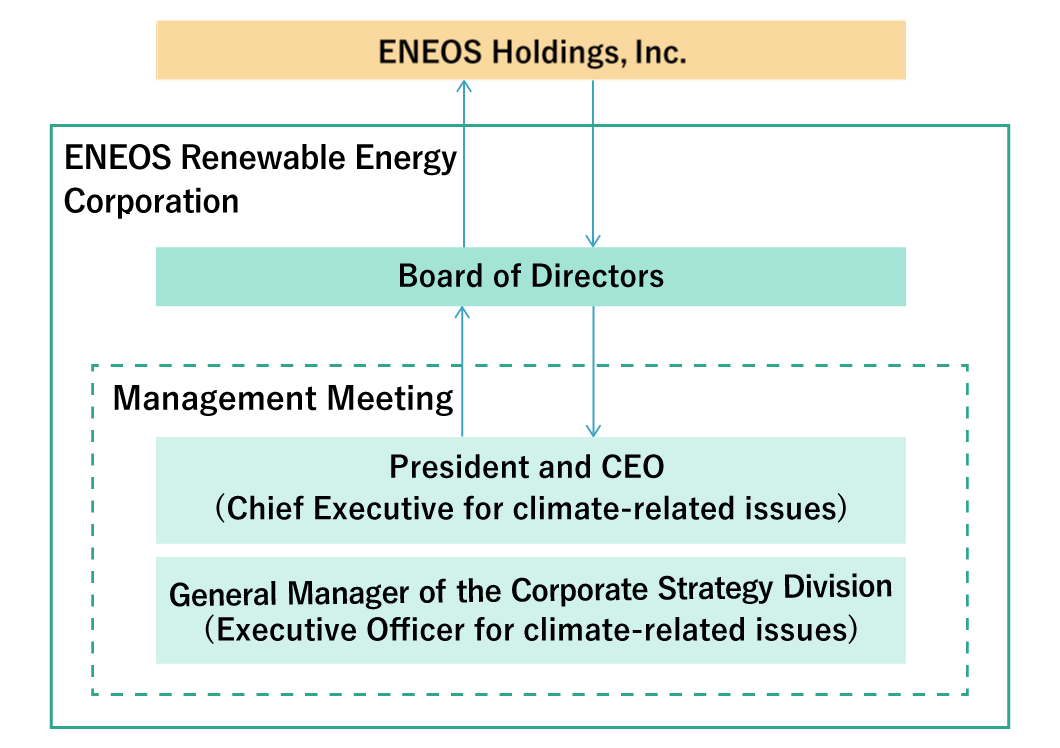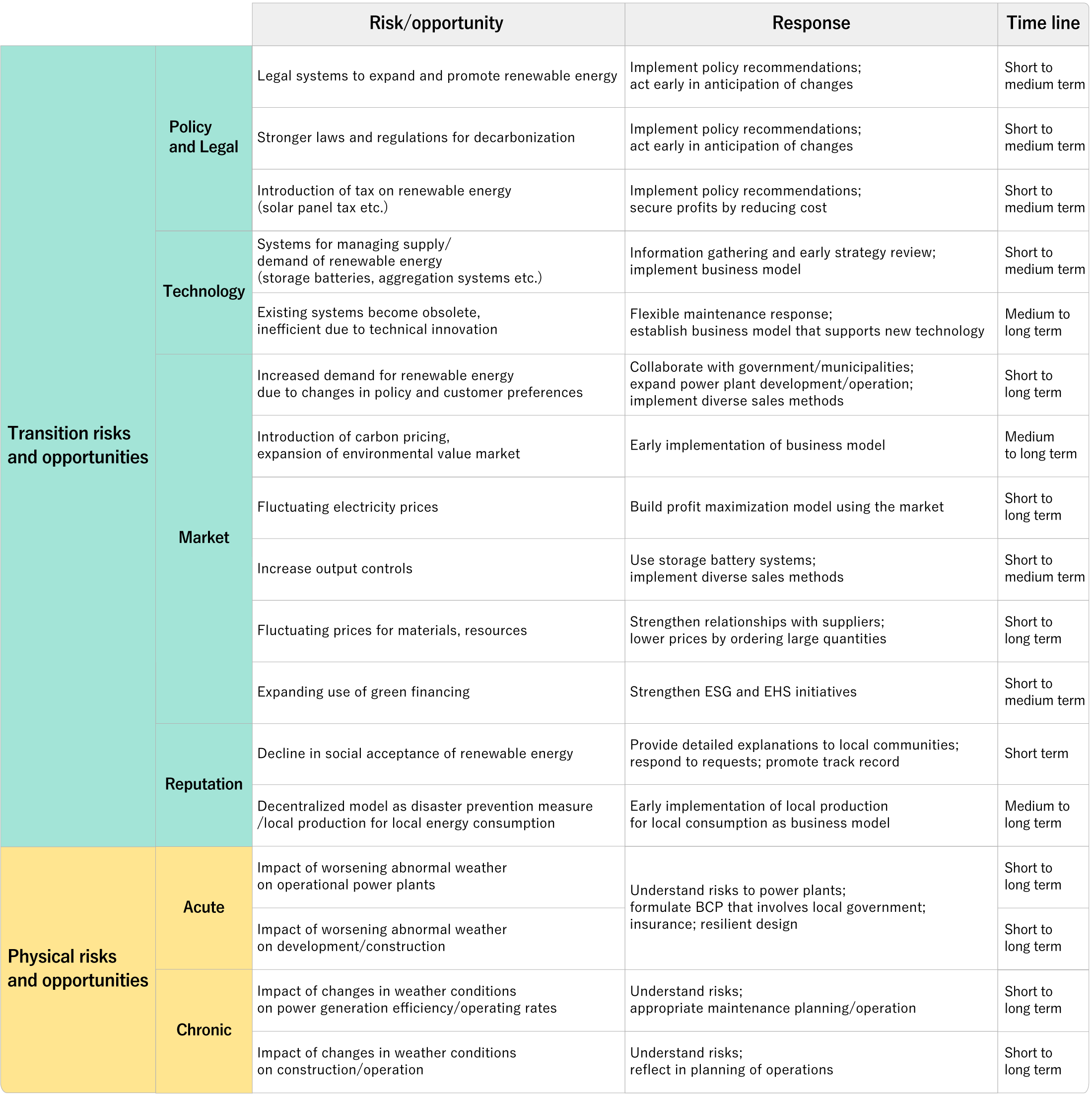Sustainability
ENEOS Renewable Energy recognizes climate change as scientific fact. We believe it is imperative to take measures against escalating damage from natural disasters caused by climate change, such as intensifying typhoons, flooding, and rising sea levels around the world. Climate change alters the natural environment and social structures with significant impact on our operations and the business as a whole. In addition, generating energy from renewable sources is an important measure to reduce CO2 emissions. We therefore recognize that there are significant opportunities to expand our business, which is to generate energy from renewable sources.

The ENEOS Group, which includes ENEOS Renewable Energy, declared its support for the recommendations of the Task Force on Climate-related Financial Disclosures (TCFD) in May 2019, and is currently strengthening and enhancing information disclosure. As a leading company in generating renewable energy, ENEOS Renewable Energy discloses information in line with the TCFD recommendations in order to contribute to finding solutions to climate-related issues for society as a whole.

Efforts to address climate-related issues are discussed and decided at the Management Meeting, which is chaired by the President and CEO and whose members include executives and general managers. The President and CEO is also the Chief Executive for climate-related issues. The General Manager of the Corporate Strategy Division acts as Executive Officer for climate-related issues with responsibility for practical implementation. Matters related to climate change responses, such as identifying and evaluating the impact of climate change, managing risks and opportunities, progress with initiatives to mitigate and adapt, and setting indicators and goals, are reported to the Chief Executive at least once a year at the Management Meeting. The Chief Executive takes the final decisions after the attendees have discussed all items on the agenda.
The President and CEO, who is also Chief Executive for climate-related issues, reports resolutions and progress with climate change initiatives to the Board of Directors, which monitors and supervises the business and issues directives as necessary. A portion of the remuneration paid to all executives and employees is based on the status of our climate-related initiatives.
The present scenario analysis covers renewable energy power generation and related businesses, which account for 100% of sales at Japan Renewable Energy Corporation, ENEOS Renewable Energy Management Corporation, and ENEOS Renewable Energy Solutions Corporation.
The TCFD recommendations suggest describing the resilience of company strategy based on multiple scenarios, including an increase in temperatures of 2ºC or lower. We conducted scenario analyses for our business in order to consider climate-related risks and opportunities for the company. The outline of the scenario analysis is as follows. The section below titled Risk Management outlines the scenario analysis together with the process of identifying and evaluating risks and opportunities at our company.
* Please scroll horizontally to see the table below.
| Source | 1.5ºC/2℃ scenario | 4℃ scenario |
|---|---|---|
|
IEA |
IEA NZE2050 scenario |
IEA STEPS scenario |
|
IPCC |
IPCC RCP2.6 scenario |
IPCC RCP8.5 scenario |
The ENEOS Group also consulted the IEA APS scenario.
【Vision of the world under the 1.5ºC/2ºC scenario】
The 1.5ºC/2ºC scenario aims to achieve the targets of the Paris Agreement and to implement a decarbonized society. To achieve meaningful reduction of greenhouse gas emissions, significant progress will be made in the areas of policies, regulations, technological innovation, dissemination of renewable energy, and energy conservation. In this vision of the future, the increase in global average temperature by the end of this century will be no more than 1.5ºC/2ºC above preindustrial levels. This is a scenario where the climate-related transition risks are relatively greater than the physical risks.
【Vision of the world under the 4ºC scenario】
Under the 4℃ scenario, measures to realize a decarbonized society, including regulations and taxation, technological innovation, the spread of renewable energy, and energy conservation, will not be sufficiently implemented, leading to a significant increase in greenhouse gas emissions. In this vision of the future, the average global temperature will rise by more than 4ºC above preindustrial levels by the end of this century. This is a scenario where the physical risks from climate disasters are relatively greater than the transition risks.
ENEOS Renewable Energy has carried out scenario analysis to identify the risks and opportunities and evaluate the impact on the business. We have conducted a qualitative evaluation of the financial impact while referring to the abovementioned scenarios. The table below summarizes the points of major impact and our thoughts on the responses.
* Please enlarge to see the table below.

The following is an outline of our processes for managing climate-related risk.
To identify and evaluate climate-related risks and opportunities, the Executive Officer for climate-related issues convenes a meeting of persons in charge to identify related risks and opportunities. Significant risks and opportunities related to climate issues are discussed at the Management Meeting.
With regard to significant climate-related risks to business and financial planning that have been identified and evaluated by the Management Meeting, the Chief Executive for climate-related issues designates the responsible persons or departments and instructs them to formulate countermeasures.
With regard to initiatives to mitigate risks and to realize opportunities, we attempt, where possible, to define the relevant Key Performance Indicators (KPIs) and to set targets and monitor them.
ENEOS Renewable Energy establishes the Key Performance Indicators (KPIs) and targets outlined below, while managing and monitoring risks and opportunities.
| Indicators * | Targets * |
|---|---|
|
Reduce greenhouse gas emissions |
FY2040 carbon neutrality |
|
Expand installed capacity for renewable energy |
FY2025:2 GW |
* Indicators and targets for the ENEOS Group as a whole
| Our track record |
|---|
|
The information is disclosed on the following pages. |
Read more
Read more
Read more
Read more
Read more
Read more